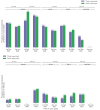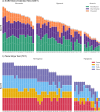Chemosensory assessment and impact on quality of life in neurosensorial cluster of the post COVID 19 syndrome
- PMID: 39251830
- PMCID: PMC11384755
- DOI: 10.1038/s41598-024-71475-3
Chemosensory assessment and impact on quality of life in neurosensorial cluster of the post COVID 19 syndrome
Abstract
COVID-19 pandemic brought chemosensory impairment to the forefront of medicine, revealing gaps in the knowledge of pathophysiological mechanisms, true prevalence and preventive/therapeutic alternatives. This is a sub-study of the ORCHESTRA cohort focusing on post-COVID-19 chemosensory symptoms. Risk factors for neurosensorial cluster of post-COVID-19 syndrome (NSc-PCS) were assessed through multivariable analysis. Psychophysical validated tests were applied on a sub-population of 50 patients. Qualitative chemosensory symptoms as well as nasal and oral chemesthesis were evaluated through anamnestic interview and the quality of life through the SF-36 questionnaire. Chemosensory symptoms evolution and olfactory training's outcome were assessed through phone-call interviews. Out of 1187 patients (female, N = 630), 550 (47%) presented NSc-PCS, with a lower risk for older age and monoclonal antibodies treatment, and a higher risk in females (p < 0.001). Out of the 50 patients evaluated with psychophysical tests, 66% showed smell reduction with a qualitative alteration in 50% of hyposmic and 35% of normosmic patients. Hypogeusia was present in 14 (28%) of the patients assessed, with 56% showing a qualitative alteration; 53% of normogeusic patients presented qualitative disorders. NSc-PCS has a complex, fluctuating, multifaceted presentation. Quantifying and characterizing COVID-19-related chemosensory impairment is key to understand underlying mechanisms and to develop preventive and therapeutic treatment.
Keywords: Chemosensory impairment; Post-COVID syndrome; SARS-CoV-2 long-term sequelae.
© 2024. The Author(s).
Conflict of interest statement
The authors declare no competing interests.
Figures



References
MeSH terms
Grants and funding
LinkOut - more resources
Full Text Sources
Medical
Miscellaneous

